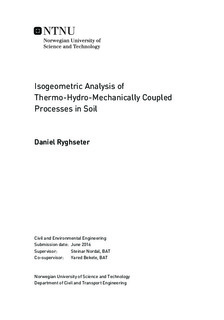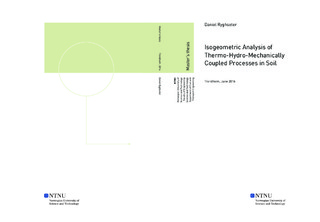| dc.description.abstract | This thesis conducts numerical studies on THM (Thermo-Hydro-Mechanically) coupled problems, using isogeometric elements and two models created at NTNU. One model is for fully saturated porous media, and the second is expanded to represent ground freezing.
Discontinuities and singularities has proven difficult to represent in THM-modeling using the conventional FEM (Finite Element Method), leading to the development of the XFEM (Extended Finite Element Method). The XFEM relays on replacing the basis functions near a discontinuity, which in some cases can be quite tiresome. This thesis has applied the isogeometric THM-model for fully saturated soil to recreate simulations conducted using the XFEM. Without any alteration to the basis functions, the isogeometric model yields results comparable to the XFEM simulations. The simulations includes a crack in thermal loading, a dam seepage problem and a fully coupled problem.
For the second part of the thesis, the THM-model with ground freezing was utilised for simulations of the frost heave phenomena. Since the model is new, and still under development, a parametric study is first presented. Then a laboratory test with a frost heave cell was attempted recreated, and the effect of seasonal temperature variation was investigated. Finally, the THM-model with ground freezing was used in an attempt to recreate two stretches of railway damaged by frost heave. The parametric study indicates that besides the phase change parameters, the stiffness and hydraulic conductivity probably affects the solutions the most. The simulations of seasonal temperature variation, clearly shows how the ground freezing affects the temperature profiles and surface heave. The attempts to recreate laboratory and field results only partially succeeds. Some aspects of the problems are simulated better than others, and a main contributor to this problem is assumed to be the linearly elastic material model. The thesis show that there is need for further research, but also illustrates the potential and strength in a fully couped THM analysis. | |

